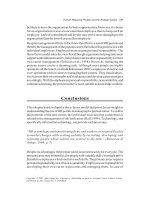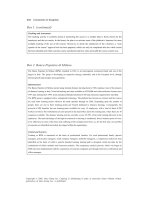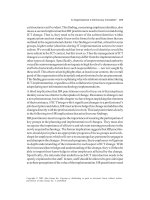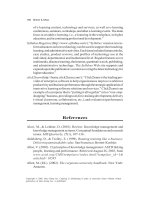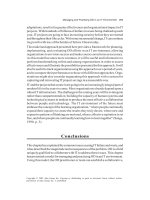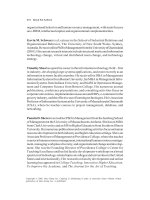Human-Resource-Management-1581538411
Bạn đang xem bản rút gọn của tài liệu. Xem và tải ngay bản đầy đủ của tài liệu tại đây (20.89 MB, 451 trang )
Human Resource Management
Human Resource Management
[Author removed at request of original publisher]
UNIVERSITY OF MINNESOTA LIBRARIES PUBLISHING EDITION, 2016. THIS EDITION ADAPTED
FROM A WORK ORIGINALLY PRODUCED IN 2011 BY A PUBLISHER WHO HAS REQUESTED THAT IT
NOT RECEIVE ATTRIBUTION.
MINNEAPOLIS, MN
Human Resource Management by University of Minnesota is licensed under a Creative Commons Attribution-NonCommercial-ShareAlike
4.0 International License, except where otherwise noted.
Contents
Publisher Information
viii
Chapter 1: The Role of Human Resources
1.1 What Is Human Resources?
1.2 Skills Needed for HRM
1.3 Today’s HRM Challenges
1.4 Cases and Problems
2
11
15
26
Chapter 2: Developing and Implementing Strategic HRM Plans
2.1 Strategic Planning
2.2 Writing the HRM Plan
2.3 Tips in HRM Planning
2.4 Cases and Problems
29
40
48
52
Chapter 3: Diversity and Multiculturalism
3.1 Diversity and Multiculturalism
3.2 Diversity Plans
3.3 Multiculturalism and the Law
3.4 Cases and Problems
55
61
68
77
Chapter 4: Recruitment
4.1 The Recruitment Process
4.2 The Law and Recruitment
4.3 Recruitment Strategies
4.4 Cases and Problems
80
89
95
107
Chapter 5: Selection
5.1 The Selection Process
5.2 Criteria Development and Résumé Review
5.3 Interviewing
5.4 Testing and Selecting
5.5 Making the Offer
5.6 Cases and Problems
111
115
120
128
134
137
Chapter 6: Compensation and Benefits
6.1 Goals of a Compensation Plan
6.2 Developing a Compensation Package
6.3 Types of Pay Systems
6.4 Other Types of Compensation
6.5 Cases and Problems
141
144
148
165
177
Chapter 7: Retention and Motivation
7.1 The Costs of Turnover
7.2 Retention Plans
7.3 Implementing Retention Strategies
7.4 Cases and Problems
181
187
201
212
Chapter 8: Training and Development
8.1 Steps to Take in Training an Employee
8.2 Types of Training
8.3 Training Delivery Methods
8.4 Designing a Training Program
8.5 Cases and Problems
217
223
230
237
253
Chapter 9: Successful Employee Communication
9.1 Communication Strategies
9.2 Management Styles
9.3 Cases and Problems
257
269
277
Chapter 10: Managing Employee Performance
10.1 Handling Performance
10.2 Employee Rights
10.3 Cases and Problems
280
296
307
Chapter 11: Employee Assessment
11.1 Performance Evaluation Systems
11.2 Appraisal Methods
11.3 Completing and Conducting the Appraisal
11.4 Cases and Problems
312
319
332
341
Chapter 12: Working with Labor Unions
12.1 The Nature of Unions
12.2 Collective Bargaining
12.3 Administration of the Collective Bargaining Agreement
12.4 Cases and Problems
347
359
365
369
Chapter 13: Safety and Health at Work
13.1 Workplace Safety and Health Laws
13.2 Health Hazards at Work
13.3 Cases and Problems
373
382
400
Chapter 14: International HRM
14.1 Offshoring, Outsourcing
14.2 Staffing Internationally
14.3 International HRM Considerations
14.4 Cases and Problems
404
418
423
440
Please share your supplementary material!
443
Publisher Information
Human Resource Management is
adapted from a work produced and
distributed under a Creative Commons
license (CC BY-NC-SA) in 2011 by a
publisher who has requested that they
and the original author not receive
attribution. This adapted edition is
produced by the University of Minnesota Libraries Publishing through the eLearning Support Initiative.
This adaptation has reformatted the original text, and replaced some images and figures to make the resulting
whole more shareable. This adaptation has not significantly altered or updated the original 2011 text. This work
is made available under the terms of a Creative Commons Attribution-NonCommercial-ShareAlike license.
viii
Chapter 1: The Role of Human Resources
Human Resource Management Day to Day
You have just been hired to work in the human resource department of a small company. You heard about the job
through a conference you attended, put on by the Society for Human Resource Management (SHRM). Previously,
the owner of the company, Jennifer, had been doing everything related to human resource management (HRM).
You can tell she is a bit critical about paying a good salary for something she was able to juggle all on her own.
On your first day, you meet the ten employees and spend several hours with the company owner, hoping to get a
handle on which human resource processes are already set up.
Shortly after the meeting begins, you see she has a completely different perspective of what HRM is, and you
realize it will be your job to educate her on the value of a human resource manager. You look at it as a personal
challenge—both to educate her and also to show her the value of this role in the organization.
First, you tell her that HRM is a strategic process having to do with the staffing, compensation, retention, training,
and employment law and policies side of the business. In other words, your job as human resources (HR) manager
will be not only to write policy and procedures and to hire people (the administrative role) but also to use strategic
plans to ensure the right people are hired and trained for the right job at the right time. For example, you ask her
if she knows what the revenue will be in six months, and Jennifer answers, “Of course. We expect it to increase
by 20 percent.” You ask, “Have you thought about how many people you will need due to this increase?” Jennifer
looks a bit sheepish and says, “No, I guess I haven’t gotten that far.” Then you ask her about the training programs
the company offers, the software used to allow employees to access pay information online, and the compensation
policies. She responds, “It looks like we have some work to do. I didn’t know that human resources involved all
of that.” You smile at her and start discussing some of the specifics of the business, so you can get started right
away writing the strategic human resource management plan.
1
1.1 What Is Human Resources?
Learning Objectives
1. Explain the role of HRM in organizations.
2. Define and discuss some of the major HRM activities.
Every organization, large or small, uses a variety of capital to make the business work. Capital includes cash,
valuables, or goods used to generate income for a business. For example, a retail store uses registers and inventory,
while a consulting firm may have proprietary software or buildings. No matter the industry, all companies have
one thing in common: they must have people to make their capital work for them. This will be our focus
throughout the text: generation of revenue through the use of people’s skills and abilities.
What Is HRM?
Human resource management (HRM) is the process of employing people, training them, compensating them,
developing policies relating to them, and developing strategies to retain them. As a field, HRM has undergone
many changes over the last twenty years, giving it an even more important role in today’s organizations. In
the past, HRM meant processing payroll, sending birthday gifts to employees, arranging company outings, and
making sure forms were filled out correctly—in other words, more of an administrative role rather than a strategic
role crucial to the success of the organization. Jack Welch, former CEO of General Electric and management guru,
sums up the new role of HRM: “Get out of the parties and birthdays and enrollment forms.… Remember, HR is
important in good times, HR is defined in hard times” (Frasch, et. al., 2010).
It’s necessary to point out here, at the very beginning of this text, that every manager has some role relating
to human resource management. Just because we do not have the title of HR manager doesn’t mean we won’t
perform all or at least some of the HRM tasks. For example, most managers deal with compensation, motivation,
and retention of employees—making these aspects not only part of HRM but also part of management. As a result,
this book is equally important to someone who wants to be an HR manager and to someone who will manage a
business.
Human Resource Recall
Have you ever had to work with a human resource department at your job? What was the interaction like? What was the
department’s role in that specific organization?
2
1.1 What Is Human Resources? 3
The Role of HRM
Keep in mind that many functions of HRM are also tasks other department managers perform, which is what
makes this information important, despite the career path taken. Most experts agree on seven main roles that HRM
plays in organizations. These are described in the following sections.
Staffing
You need people to perform tasks and get work done in the organization. Even with the most sophisticated
machines, humans are still needed. Because of this, one of the major tasks in HRM is staffing. Staffing involves
the entire hiring process from posting a job to negotiating a salary package. Within the staffing function, there are
four main steps:
1. Development of a staffing plan. This plan allows HRM to see how many people they should hire
based on revenue expectations.
2. Development of policies to encourage multiculturalism at work. Multiculturalism in the workplace
is becoming more and more important, as we have many more people from a variety of backgrounds in
the workforce.
3. Recruitment. This involves finding people to fill the open positions.
4. Selection. In this stage, people will be interviewed and selected, and a proper compensation package
will be negotiated. This step is followed by training, retention, and motivation.
Development of Workplace Policies
Every organization has policies to ensure fairness and continuity within the organization. One of the jobs of HRM
is to develop the verbiage surrounding these policies. In the development of policies, HRM, management, and
executives are involved in the process. For example, the HRM professional will likely recognize the need for a
policy or a change of policy, seek opinions on the policy, write the policy, and then communicate that policy to
employees. It is key to note here that HR departments do not and cannot work alone. Everything they do needs to
involve all other departments in the organization. Some examples of workplace policies might be the following:
• Discipline process policy
• Vacation time policy
• Dress code
• Ethics policy
• Internet usage policy
4 Human Resource Management
These topics are addressed further in Chapter 6 “Compensation and Benefits”, Chapter 7 “Retention and
Motivation”, Chapter 8 “Training and Development”, and Chapter 9 “Successful Employee Communication”.
Compensation and Benefits Administration
HRM professionals need to determine that compensation is fair, meets industry standards, and is high enough to
entice people to work for the organization. Compensation includes anything the employee receives for his or her
work. In addition, HRM professionals need to make sure the pay is comparable to what other people performing
similar jobs are being paid. This involves setting up pay systems that take into consideration the number of years
with the organization, years of experience, education, and similar aspects. Examples of employee compensation
include the following:
• Pay
• Health benefits
• 401(k) (retirement plans)
• Stock purchase plans
• Vacation time
• Sick leave
• Bonuses
• Tuition reimbursement
Since this is not an exhaustive list, compensation is discussed further in Chapter 6 “Compensation and Benefits”.
Retention
Retention involves keeping and motivating employees to stay with the organization. Compensation is a major
factor in employee retention, but there are other factors as well. Ninety percent of employees leave a company for
the following reasons:
1. Issues around the job they are performing
2. Challenges with their manager
3. Poor fit with organizational culture
4. Poor workplace environment
Despite this, 90 percent of managers think employees leave as a result of pay (Rivenbark, 2010). As a result,
managers often try to change their compensation packages to keep people from leaving, when compensation isn’t
the reason they are leaving at all. Chapter 7 “Retention and Motivation” and Chapter 11 “Employee Assessment”
discuss some strategies to retain the best employees based on these four factors.
1.1 What Is Human Resources? 5
Training and Development
Once we have spent the time to hire new employees, we want to make sure they not only are trained to do the
job but also continue to grow and develop new skills in their job. This results in higher productivity for the
organization. Training is also a key component in employee motivation. Employees who feel they are developing
their skills tend to be happier in their jobs, which results in increased employee retention. Examples of training
programs might include the following:
• Job skills training, such as how to run a particular computer program
• Training on communication
• Team-building activities
• Policy and legal training, such as sexual harassment training and ethics training
We address each of these types of training and more in detail in Chapter 8 “Training and Development”.
Dealing with Laws Affecting Employment
Human resource people must be aware of all the laws that affect the workplace. An HRM professional might work
with some of these laws:
• Discrimination laws
• Health-care requirements
• Compensation requirements such as the minimum wage
• Worker safety laws
• Labor laws
The legal environment of HRM is always changing, so HRM must always be aware of changes taking place and
then communicate those changes to the entire management organization. Rather than presenting a chapter focused
on HRM laws, we will address these laws in each relevant chapter.
Worker Protection
Safety is a major consideration in all organizations. Oftentimes new laws are created with the goal of setting
federal or state standards to ensure worker safety. Unions and union contracts can also impact the requirements
for worker safety in a workplace. It is up to the human resource manager to be aware of worker protection
requirements and ensure the workplace is meeting both federal and union standards. Worker protection issues
might include the following:
• Chemical hazards
6 Human Resource Management
• Heating and ventilation requirements
• Use of “no fragrance” zones
• Protection of private employee information
We take a closer look at these issues in Chapter 12 “Working with Labor Unions” and Chapter 13 “Safety and
Health at Work”.
Figure 1.1
Caption: Knowing the law regarding worker protection is generally the job of human resources. In some industries it is extremely
important; in fact, it can mean life or death.
ReSurge International – Tom Davenport Operating On A Patient – CC BY-NC-ND 2.0.
Communication
Besides these major roles, good communication skills and excellent management skills are key to successful
human resource management as well as general management. We discuss these issues in Chapter 9 “Successful
Employee Communication”.
Awareness of External Factors
In addition to managing internal factors, the HR manager needs to consider the outside forces at play that may
1.1 What Is Human Resources? 7
affect the organization. Outside forces, or external factors, are those things the company has no direct control
over; however, they may be things that could positively or negatively impact human resources. External factors
might include the following:
1. Globalization and offshoring
2. Changes to employment law
3. Health-care costs
4. Employee expectations
5. Diversity of the workforce
6. Changing demographics of the workforce
7. A more highly educated workforce
8. Layoffs and downsizing
9. Technology used, such as HR databases
10. Increased use of social networking to distribute information to employees
For example, the recent trend in flexible work schedules (allowing employees to set their own schedules) and
telecommuting (allowing employees to work from home or a remote location for a specified period of time, such
as one day per week) are external factors that have affected HR. HRM has to be aware of these outside issues,
so they can develop policies that meet not only the needs of the company but also the needs of the individuals.
Another example is the Patient Protection and Affordable Care Act, signed into law in 2010. Compliance with
this bill has huge implications for HR. For example, a company with more than fifty employees must provide
health-care coverage or pay a penalty. Currently, it is estimated that 60 percent of employers offer health-care
insurance to their employees (Cappelli, 2010). Because health-care insurance will be mandatory, cost concerns
as well as using health benefits as a recruitment strategy are big external challenges. Any manager operating
without considering outside forces will likely alienate employees, resulting in unmotivated, unhappy workers. Not
understanding the external factors can also mean breaking the law, which has a concerning set of implications as
well.
Figure 1.2
8 Human Resource Management
An understanding of key external factors is important to the successful HR professional. This allows him or her to be able to make
strategic decisions based on changes in the external environment. To develop this understanding, reading various publications is
necessary.
One way managers can be aware of the outside forces is to attend conferences and read various articles on the
web. For example, the website of the Society for Human Resource Management, SHRM Online1, not only has job
postings in the field but discusses many contemporary human resource issues that may help the manager make
better decisions when it comes to people management. In Section 1.3 “Today’s HRM Challenges”, we go into
more depth about some recent external issues that are affecting human resource management roles. In Section
1.1.2 “The Role of HRM”, we discuss some of the skills needed to be successful in HRM.
Figure 1.3
1.1 What Is Human Resources? 9
Most professionals agree that there are seven main tasks HRM professionals perform. All these need to be considered in relation to
external and outside forces.
Key Takeaways
• Capital includes all resources a company uses to generate revenue. Human resources or the people working
in the organization are the most important resource.
• Human resource management is the process of employing people, training them, compensating them,
developing policies relating to the workplace, and developing strategies to retain employees.
• There are seven main responsibilities of HRM managers: staffing, setting policies, compensation and
benefits, retention, training, employment laws, and worker protection. In this book, each of these major
areas will be included in a chapter or two.
• In addition to being concerned with the seven internal aspects, HRM managers must keep up to date with
changes in the external environment that may impact their employees. The trends toward flexible schedules
and telecommuting are examples of external aspects.
• To effectively understand how the external forces might affect human resources, it is important for the HR
manager to read the HR literature, attend conferences, and utilize other ways to stay up to date with new
laws, trends, and policies.
10 Human Resource Management
Exercises
1. State arguments for and against the following statement: there are other things more valuable in an
organization besides the people who work there.
2. Of the seven tasks an HR manager does, which do you think is the most challenging? Why?
1
Society for Human Resource Management, accessed August 18, 2011, />
References
Cappelli, P., “HR Implications of Healthcare Reform,” Human Resource Executive Online, March 29, 2010,
accessed August 18, 2011, />Frasch, K. B., David Shadovitz, and Jared Shelly, “There’s No Whining in HR,” Human Resource Executive
Online,
June
30,
2009,
accessed
September
24,
2010,
/>story.jsp?storyId=227738167.
Rivenbark, L., “The 7 Hidden Reasons Why Employees Leave,” HR Magazine, May 2005, accessed October 10,
2010, />
1.2 Skills Needed for HRM
Learning Objectives
1. Explain the professional and personal skills needed to be successful in HRM.
2. Be able to define human resource management and the certifications that can be achieved in this profession.
One of the major factors of a successful manager or human resource (HR) manager is an array of skills to deal
with a variety of situations. It simply isn’t enough to have knowledge of HR, such as knowing which forms need
to be filled out. It takes multiple skills to create and manage people, as well as a cutting-edge human resource
department.
The first skill needed is organization. The need for this skill makes sense, given that you are managing people’s
pay, benefits, and careers. Having organized files on your computer and good time-management skills are crucial
for success in any job, but especially if you take on a role in human resources.
Like most jobs, being able to multitask—that is, work on more than one task at a time—is important in managing
human resources. A typical person managing human resources may have to deal with an employee issue one
minute, then switch and deal with recruiting. Unlike many management positions, which only focus on one task
or one part of the business, human resources focuses on all areas of the business, where multitasking is a must.
As trite as it may sound, people skills are necessary in any type of management and perhaps might be the most
important skills for achieving success at any job. Being able to manage a variety of personalities, deal with
conflict, and coach others are all in the realm of people management. The ability to communicate goes along with
people skills. The ability to communicate good news (hiring a new employee), bad news (layoffs), and everything
in between, such as changes to policy, makes for an excellent manager and human resource management (HRM)
professional.
Keys to a successful career in HRM or management include understanding specific job areas, such as managing
the employee database, understanding employment laws, and knowing how to write and develop a strategic plan
that aligns with the business. All these skills will be discussed in this book.
A strategic mind-set as an HR professional is a key skill as well. A person with a strategic mind-set can plan far
in advance and look at trends that could affect the environment in which the business is operating. Too often,
managers focus on their own area and not enough on the business as a whole. The strategic HR professional is
able to not only work within his or her area but also understand how HR fits into the bigger picture of the business.
Ethics and a sense of fairness are also necessary in human resources. Ethics is a concept that examines the
moral rights and wrongs of a certain situation. Consider the fact that many HR managers negotiate salary and
union contracts and manage conflict. In addition, HR managers have the task of ensuring compliance with ethics
11
12 Human Resource Management
standards within the organization. Many HR managers are required to work with highly confidential information,
such as salary information, so a sense of ethics when managing this information is essential. We discuss ethics
from the organizational perspective in Section 1.1.2 “The Role of HRM”.
Dilbert and the Evil HR Director
" href=" class="replaced-iframe">(click to see video)
Ethics is perhaps one of the most important aspects to being a great HR professional. This humorous video shows
how unethical behavior can undermine motivation at work.
Human Resource Recall
Think of your current skills. Are there personal or professional skills you would like to work on?
Finally, while we can list a few skills that are important, understanding the particular business, knowing the
business strategy, and being able to think critically about how HR can align itself with the strategy are ways
to ensure HR departments are critical parts of the business. HR is a specialized area, much like accounting or
finance. However, many individuals are placed in HR roles without having the specific knowledge to do the
job. Oftentimes people with excellent skills are promoted to management and then expected (if the company is
small) to perform recruiting, hiring, and compensation tasks. This is the reason we will refer to management
and HR management interchangeably throughout the chapters. In addition, these skills are important for HRM
professionals and managers alike.
Having said that, for those of you wanting a career in HRM, there are three exams you can take to show your
mastery of HRM material:
1. Professional in Human Resources (PHR). To take this exam, an HR professional must have at least
two years’ experience. The exam is four hours long and consists of 225 multiple-choice questions in a
variety of areas. Twelve percent of the test focuses on strategic management, 26 percent on workforce
planning, 17 percent on human resource development, 16 percent on rewards, 22 percent on employee
and labor relations, and 7 percent on risk management. The application process for taking the exam is
given on the Human Resource Certification Institute website at .
2. Senior Professional in Human Resources (SPHR). This exam is designed for HR professionals who
focus on designing and planning, rather than actual implementation. It is recommended that the person
taking this exam has six to eight years of experience and oversees and manages an HR department. In
this test, the greater focus is on the strategic aspect of HRM.
3. Global Professional in Human Resources (GPHR). This exam is for HR professionals who perform
many of their tasks on a global level and whose companies often work across borders. This exam is
three hours long, with 165 multiple-choice questions. A person with two years of professional
experience can take the certification test. However, because the test has the international aspect,
someone who designs HR-related programs and processes to achieve business goals would be best
1.2 Skills Needed for HRM 13
suited to earn this certification.
The benefits of achieving certifications are great. In addition to demonstrating the abilities of the HR professional,
certification allows the professional to be more marketable in a very competitive field.
Figure 1.4
Caption: Perhaps one of the most important skills in any kind of management is the ability to communicate.
Baltic Development Forum – Kristovskis-meeting-41.jpg – CC BY 2.0.
Most companies need a human resource department or a manager with HR skills. The industries and job titles are
so varied that it is possible only to list general job titles in human resources:
1. Recruiter
2. Compensation analyst
3. Human resources assistant
4. Employee relations manager
5. Benefits manager
6. Work-life coordinator
7. Training and development manager
8. Human resources manager
9. Vice president for human resources
14 Human Resource Management
This is not an exhaustive list, but it can be a starting point for research on this career path.
People Skills in HR
" href=" class="replaced-iframe">(click to see video)
This chapter makes the point that communication and people skills, or “soft skills,” are necessary to be successful
in any job. This video addresses the importance of these skills.
Key Takeaways
• There are a number of skills crucial to human resource management. First, being able to organize and
multitask is necessary. In this job, files must be managed, and an HR manager is constantly working in
different areas of the business.
• Communication skills are necessary in HRM as well. The ability to present good and bad news, work with a
variety of personalities, and coach employees is important in HRM.
• Specific job skills, such as computer skills, knowledge of employment law, writing and developing strategic
plans, and general critical-thinking skills are important in any type of management, but especially in human
resource management.
• A sense of fairness and strong ethics will make for the best HR manager. Because HR works with a variety
of departments to manage conflict and negotiate union contracts and salary, the HR professional needs
ethics skills and the ability to maintain confidentiality.
• Since one of the major responsibilities of an HR department is to align the HR strategic plan with the
business strategic plan, critical and creative thinking, as well as writing, are skills that will benefit the HR
manager as well.
• Many people find themselves in the role of HR manager, so we will use the term HR manager throughout
this book. However, many other types of managers also perform the tasks of recruiting, selecting, and
compensating, making this book and the skills listed in this section applicable to all majors.
• Certification exams can be taken to make you more marketable in the field of HRM. These certifications are
offered by the HR Certification Institute (HRCI).
Exercise
1. What are your perceptions of what an HR manager does on a day-to-day basis? Research this job title and
describe your findings. Is this the type of job you expected?
1.3 Today’s HRM Challenges
If you were to ask most business owners what their biggest challenges are, they will likely tell you that cost
management is a major factor to the success or failure of their business. In most businesses today, the people part
of the business is the most likely place for cuts when the economy isn’t doing well.
Consider the expenses that involve the people part of any business:
1. Health-care benefits
2. Training costs
3. Hiring process costs
4. And many more…
These costs cut into the bottom line of any business. The trick is to figure out how much, how many, or how often
benefits should be offered, without sacrificing employee motivation. A company can cut costs by not offering
benefits or 401(k) plans, but if its goal is to hire the best people, a hiring package without these items will most
certainly not get the best people. Containment of costs, therefore, is a balancing act. An HR manager must offer
as much as he or she can to attract and retain employees, but not offer too much, as this can put pressure on the
company’s bottom line. We will discuss ways to alleviate this concern throughout this book.
For example, there are three ways to cut costs associated with health care:
1. Shift more of the cost of health care to employees
2. Reduce the benefits offered to cut costs
3. Change or better negotiate the plan to reduce health-care costs
Health care costs companies approximately $4,003 per year for a single employee and $9,764 for families. This
equals roughly 83 percent and 73 percent of total health-care costs for single employees and employees with
families1, respectively. One possible strategy for containment for health-care plans is to implement a cafeteria
plan. Cafeteria plans started becoming popular in the 1980s and have become standard in many organizations
(Allen, 2010). This type of plan gives all employees a minimum level of benefits and a set amount to spend
on flexible benefits, such as additional health care or vacation time. It creates more flexible benefits, allowing
the employee, based on his or her family situation, to choose which benefits are right for them. For example, a
mother of two may choose to spend her flexible benefits on health care for her children, while a single, childless
female may opt for more vacation days. In other words, these plans offer flexibility, while saving money, too. Cost
containment strategies around benefits will be discussed in Chapter 6 “Compensation and Benefits”.
Another way to contain costs is by offering training. While this may seem counterintuitive, as training does
cost money up front, it can actually save money in the long run. Consider how expensive a sexual harassment
lawsuit or wrongful termination lawsuit might be. For example, a Sonic Drive-In was investigated by the Equal
Opportunity Employment Commission (EEOC) on behalf of seventy women who worked there, and it was found
15
16 Human Resource Management
that a manager at one of the stores subjected the victims to inappropriate touching and comments. This lawsuit
cost the organization $2 million2. Some simple training up front (costing less than the lawsuit) likely would have
prevented this from happening. Training employees and management on how to work within the law, thereby
reducing legal exposure, is a great way for HR to cut costs for the organization as a whole. In Chapter 8 “Training
and Development”, we will further discuss how to organize, set up, and measure the success of a training program.
The hiring process and the cost of turnover in an organization can be very expensive. Turnover refers to the
number of employees who leave a company in a particular period of time. By creating a recruiting and selection
process with cost containment in mind, HR can contribute directly to cost-containment strategies company wide.
In fact, the cost of hiring an employee or replacing an old one (turnover) can be as high as $9,777 for a position
that pays $60,000 (Del Monte, 2010). By hiring smart the first time, HR managers can contain costs for their
organization. This will be discussed in Chapter 4 “Recruitment” and Chapter 5 “Selection”. Reducing turnover
includes employee motivational strategies. This will be addressed in Chapter 7 “Retention and Motivation”.
In a survey reported on by the Sales and Marketing Management newsletter3, 85 percent of managers say that
ineffective communication is the cause of lost revenue. E-mail, instant messaging, text messages, and meetings
are all examples of communication in business. An understanding of communication styles, personality styles, and
channels of communication can help us be more effective in our communications, resulting in cost containment.
In HRM, we can help ensure our people have the tools to communicate better, and contain costs and save dollars
in doing so. Some of these tools for better communication will be addressed in Chapter 9 “Successful Employee
Communication”.
One cost-containment strategy for US businesses has been offshoring. Offshoring refers to the movement of jobs
overseas to contain costs. It is estimated that 3.3 million US jobs will be moved overseas by 2015 (Agrawal &
Farrell, 2003). According to the US Census Bureau, most of these jobs are Information Technology (IT) jobs
as well as manufacturing jobs. This issue is unique to HR, as the responsibility for developing training for new
workers and laying off domestic workers will often fall under the realm of HRM. Offshoring will be discussed
in Chapter 14 “International HRM”, and training for new workers will be discussed in Chapter 8 “Training and
Development”.
Figure 1.5
1.3 Today’s HRM Challenges 17
Caption: One of the biggest contemporary challenges in HRM is figuring out the balance between what benefits to offer versus the
impact those benefits have on employee motivation.
winnifredxoxo – balance scale – CC BY 2.0.
Of course, cost containment isn’t only up to HRM and managers, but as organizations look at various ways to
contain costs, human resources can certainly provide solutions.
Technology
Technology has greatly impacted human resources and will continue to do so as new technology is developed.
Through use of technology, many companies have virtual workforces that perform tasks from nearly all corners
of the world. When employees are not located just down the hall, management of these human resources creates
some unique challenges. For example, technology creates an even greater need to have multicultural or diversity
understanding. Since many people will work with individuals from across the globe, cultural sensitivity and
understanding is the only way to ensure the use of technology results in increased productivity rather than
decreased productivity due to miscommunications. Chapter 3 “Diversity and Multiculturalism” and Chapter 14
“International HRM” will discuss some specific diversity issues surrounding a global workforce.
Technology also creates a workforce that expects to be mobile. Because of the ability to work from home or
anywhere else, many employees may request and even demand a flexible schedule to meet their own family and
personal needs. Productivity can be a concern for all managers in the area of flextime, and another challenge is the
fairness to other workers when one person is offered a flexible schedule. Chapter 6 “Compensation and Benefits”
and Chapter 7 “Retention and Motivation” will discuss flextime as a way to reward employees. Many companies,


